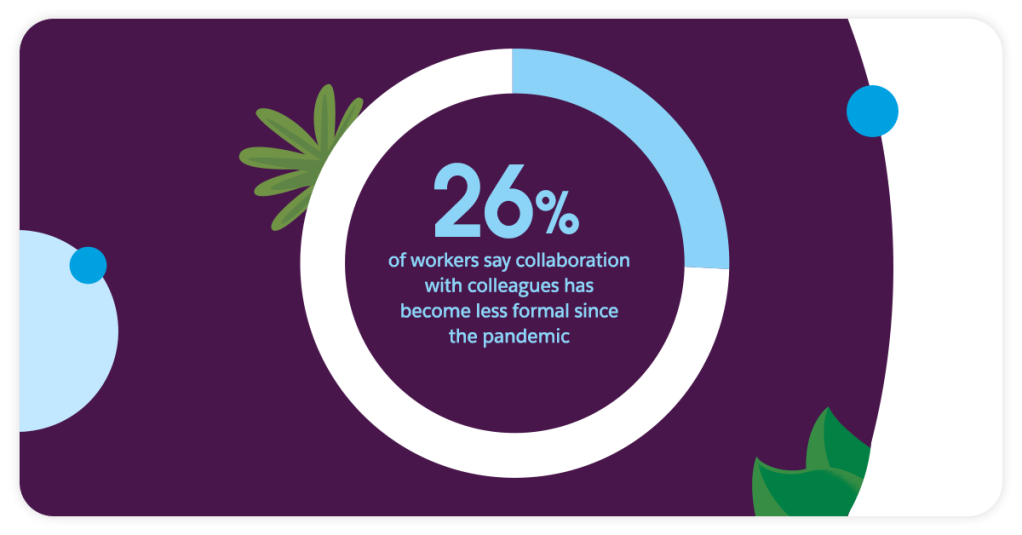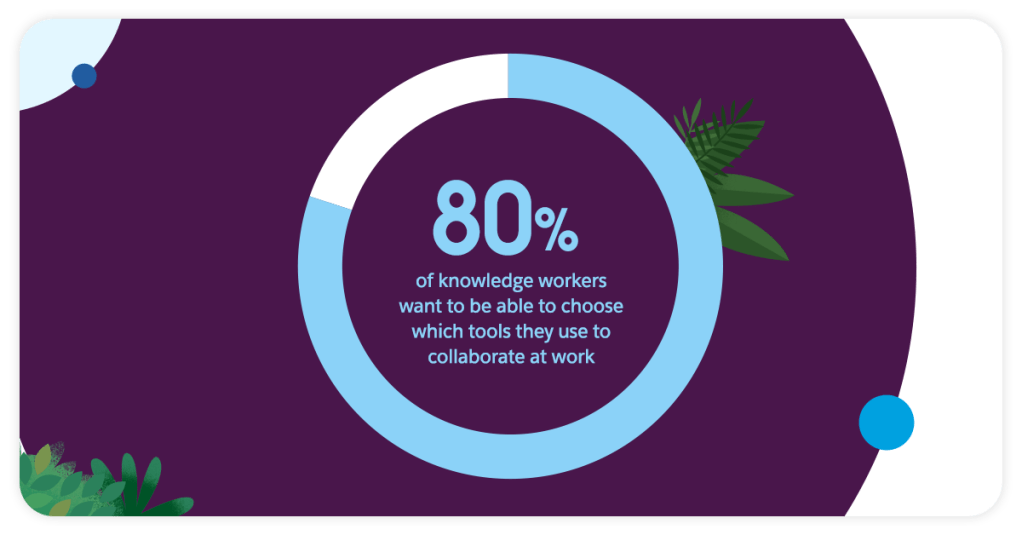Quick take: With 72% of workers using chat or channel-based collaboration tools (and nearly one in five using it with their senior leadership), the days of laboring over an email might soon be over. A new Salesforce report reveals the three ways that collaboration is shifting company culture in the eyes of employees.
The average workday looks much different now than it did a couple years ago. To get things done, employees can’t just swivel their chair around, walk over to a desk, or even organize a traditional meeting.
To uncover how collaboration has changed since the pandemic, Salesforce surveyed nearly 900 U.S.-based knowledge workers and learned how those changes are dictating company culture — both now and in the future.
Three shifts in collaboration styles rose to the top, and are beginning to shift company cultures for the better.
#1: To get things done, employees opt for informal communication
Just like maintaining long-distance relationships with friends through technology, new hybrid working models are challenging workers to collaborate with their colleagues in new and different ways.
According to the survey, 75% of workers prefer to interact with colleagues as they would a friend. We also saw that more than one-third would prefer to interact even with external customers or partners as they would a friend.
#2: Chat-based collaboration leads to stronger, more open relationships
With chat or channel-based collaboration tools paving the way for informal methods of communication, the research also explored whether these tools had a major impact on company culture.
Turns out, not only do these tools help build strong relationships by breaking down hierarchies, they provide business value as well. Nearly one half of workers say chat or channel-based collaboration tools lead to faster approvals and one in four say they lead to projects being handled more efficiently.
With 76% of workers stating that a company’s collaboration style is a direct reflection of work culture, it says a lot that nearly one in four say collaboration tools provide more direct access to senior leadership.
The days of traditional professional hierarchies and bottlenecks could be starting to fade as businesses implement technology that provides them better access to those at the top.
#3: Flexibility is critical
Collaboration is not a one-size-fits-all approach. Offering new ways to communicate in one place will become critical in building a Trusted Enterprise.
The data shows that the release of Slack Clips comes at a perfect time. With Slack Clips, users can easily create, share, and consume video and audio content in channels – empowering them to contribute to the conversation on their own time and in their way. This addition to the Slack Platform offers a more flexible way of communicating — a critical tool to building culture among a hybrid workforce.
Now, the 80% of workers that want to choose how they collaborate, can. The phrase ‘culture eats strategy for breakfast’ has never been more true.
Read more
- Explore: The Impact of Collaboration on Company Culture Tableau Dashboard
- Read: Marketing Cloud GM on How Slack-First Marketing Personalizes Campaigns Instantly
- Discover: New Slack and Salesforce Innovations Press Release
Research citation & methodology
‘Culture of Collaboration Snapshot Survey,’ Salesforce, September 2021
Salesforce conducted a double-blind online survey of knowledge workers* in the United States. Data was collected on August 31 and Sept 7, 2021 and yielded 856 responses.
*Knowledge workers’ work is primarily mental labor (i.e, professional services, business management) over manual or task-based labor (i.e, construction, onsite manufacturing, warehouse operations, retail store service/operations, food service/operations).


















